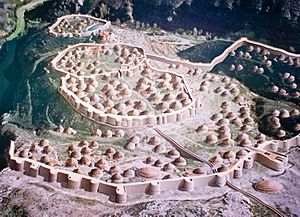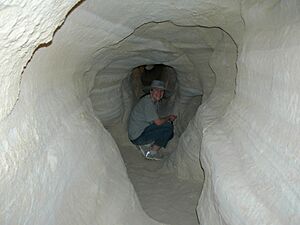Chalcolithic facts for kids
The Chalcolithic period, also known as the Copper Age or Eneolithic, was a time in history when people started using smelted copper more and more. It came after the Neolithic (New Stone Age) and before the Bronze Age. This period happened at different times in different parts of the world. For example, some places like Russia didn't have a clear Copper Age between the Stone and Bronze ages. Even though copper was being used, most tools were still made of stone during this time.
The oldest proof of high-temperature copper smelting was found at Belovode, a site on Rudnik mountain in Serbia. This discovery dates back to around 5,000 BC. In Europe, the shift from the Copper Age to the Bronze Age happened between the late 5th and late 3rd millennium BC. In the Ancient Near East, the Copper Age began in the late 5th millennium BC and lasted for about 1,000 years before the Early Bronze Age started.
A study in 2013 found early tin bronze at the Pločnik archaeological site in Serbia, dating to about 4,650 BC. Other similar items from Bulgaria and Serbia were also found from before 4,000 BC. This showed that early tin bronze was more common than thought and developed in Europe much earlier than in the Near East. In Britain, the Chalcolithic was a short time, from about 2,500 to 2,200 BC. During this period, copper and gold objects first appeared, along with new pottery styles and the arrival of Beaker culture people.
Contents
What's in a Name?
The Chalcolithic period has many names because people defined it in different ways over time. Originally, the term Bronze Age covered both times when copper or bronze was the main metal for tools and weapons.
In the 1870s, a Hungarian scientist named Ferenc Pulszky suggested adding the Copper Age. He found many large copper objects in the Carpathian Basin. This led him to think that the usual three ages—Stone, Bronze, and Iron—needed an extra one.
Later, in 1881, John Evans noticed that copper was often used before bronze. He called this a "transitional Copper Age." He saw it as a separate time at the start of the Bronze Age.
In 1884, Gaetano Chierici called it eneo-litica in Italian, meaning "bronze–stone" transition. This name simply meant it was a time when people moved from using stone to using copper. Stone tools were still used a lot, even during the Bronze and Iron Ages.
Over time, British experts used "Copper Age" or "Eneolithic." Around 1900, many started using "Chalcolithic" instead. This word comes from Greek words meaning "copper" (khalkos) and "stone" (líthos). Today, "Copper Age," "Eneolithic," and "Chalcolithic" all mean the same thing: the time when copper was first widely used.
Where Did It Happen?
Near East
The use of metals might have started in the Fertile Crescent, a region in the Middle East.
Lead was possibly the first metal people learned to melt. It's easy to get by heating a mineral called galena. Early examples of lead use have been found at sites like Jarmo and Yarim Tepe I.
Copper melting also happened around 6000 BC. The Timna Valley in Israel has proof of copper mining from 7000–5000 BC. During this time, people in the Middle East started using fewer high-quality stone tools. This change happened because copper tools became more common. For example, on the Tehran Plain in Iran, people started making stone tools from local materials at home. This suggests that the old ways of making special stone tools changed as copper use grew.
Around 4200 BC, people in eastern Turkey made copper mixed with arsenic. This created a stronger metal. Evidence of this, like furnaces and melted rock (slag), has been found at sites like Norşuntepe.
Europe
The oldest clear evidence of copper making in Europe is a copper axe found in Prokuplje, Serbia, from about 5500 BC. This discovery shows that copper smelting might have been invented in different places in Asia and Europe, not just spread from one spot.
People knew about copper even if they didn't use the metal itself. The European Battle Axe culture made stone axes that looked like copper axes. Ötzi the Iceman, whose body was found in the Ötztal Alps and dates to about 3300 BC, had a copper axe with him.

Examples of Copper Age cultures in Europe include Vila Nova de São Pedro and Los Millares in Spain. Pottery from the Beaker people has been found at these sites. The Beaker culture seems to have helped spread copper and bronze technology across Europe. In Britain, copper was used between 2500 and 2200 BC, but it wasn't used on a very large scale.
South Asia
Pottery found in the Indus Valley civilisation, southern Turkmenistan, and northern Iran shows similarities from 4300–3300 BC. This suggests a lot of movement and trade during the Copper Age.
At Bhirrana, an early Indus civilization site, copper bangles and arrowheads were discovered. People in Mehrgarh, in modern-day Pakistan, made tools from local copper ore between 7000 and 3300 BC.
The Nausharo site in Pakistan was a pottery workshop from 4,500 years ago. Archaeologists found copper blades there. These blades were used by potters to shape clay.
In India, Copper Age cultures thrived in four main farming groups: Ahar (or Banas), Kayatha, Malwa, and Jorwe. They all used painted pottery and copper, but each had its own unique pottery designs. For example, Banas culture pottery (2000–1600 BC) had red, white, and black designs.
Pandu Rajar Dhibi (2000–1600 BC) is a Copper Age site in eastern India. Many items have been found there, including pottery, copper tools, ornaments, and even pieces of fabric.
In March 2018, archaeologists found three carts and copper weapons from 1800 BC in Sanauli village in Uttar Pradesh, India. These items belong to the Ochre Coloured Pottery culture.
Pre-Columbian Americas
Andean civilizations in South America seem to have invented copper smelting on their own.
The term "Chalcolithic" is also used for American civilizations that used copper and copper alloys thousands of years before Europeans arrived. Besides cultures in the Andes and Mesoamerica, the Old Copper complex in the Great Lakes region (like Michigan and Wisconsin) mined and made copper tools, weapons, and jewelry.
Some of these sites have artifacts dating from 6500–1000 BC, making them some of the oldest Copper Age sites in the world. While some argue about whether they melted copper, many archaeologists believe that people like the Hopewellian and Mississippian peoples did cast copper objects.
East Asia
Copper items started appearing in East Asia around 5th millennium BC. These were found in cultures like Jiangzhai and Hongshan culture. However, metal tools were not widely used at this very early stage.
Copper making slowly became more common during the Yangshao period (5000–3000 BC). Remains of copper metallurgy have been found in various cultures from the late fourth to early third millennia BC. This shows that people in the Yellow River valley learned how to make copper items by the later Yangshao period.
Sub-Saharan Africa
In the Aïr Mountains region of Niger, people developed copper smelting independently between 3000 and 2500 BC. This process became more advanced around 1500 BC.
See also
 In Spanish: Edad del Cobre para niños
In Spanish: Edad del Cobre para niños


